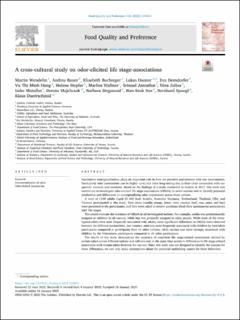Please use this identifier to cite or link to this item:
https://doi.org/10.21256/zhaw-28808Full metadata record
| DC Field | Value | Language |
|---|---|---|
| dc.contributor.author | Wendelin, Martin | - |
| dc.contributor.author | Bauer, Andrea | - |
| dc.contributor.author | Buchinger, Elisabeth | - |
| dc.contributor.author | Danner, Lukas | - |
| dc.contributor.author | Derndorfer, Eva | - |
| dc.contributor.author | Thi Minh Hang, Vu | - |
| dc.contributor.author | Hopfer, Helene | - |
| dc.contributor.author | Wallner, Marlies | - |
| dc.contributor.author | Jantathai, Srinual | - |
| dc.contributor.author | Julius, Nina | - |
| dc.contributor.author | Matullat, Imke | - |
| dc.contributor.author | Majchrzak, Dorota | - |
| dc.contributor.author | Siegmund, Barbara | - |
| dc.contributor.author | Seo, Han-Seok | - |
| dc.contributor.author | Spangl, Bernhard | - |
| dc.contributor.author | Duerrschmid, Klaus | - |
| dc.date.accessioned | 2023-09-29T09:35:06Z | - |
| dc.date.available | 2023-09-29T09:35:06Z | - |
| dc.date.issued | 2023 | - |
| dc.identifier.issn | 0950-3293 | de_CH |
| dc.identifier.issn | 1873-6343 | de_CH |
| dc.identifier.uri | https://digitalcollection.zhaw.ch/handle/11475/28808 | - |
| dc.description.abstract | Associative conceptualization plays an important role in how we perceive and interact with our environment. Particularly odor associations can be highly vivid and often long-lasting due to their close connection with our episodic memory and emotions. Based on the findings of a study conducted in Austria in 2017, this work was carried out to investigate odor-elicited life stage-associations (OELSA) in seven nations and to identify potential similarities and differences in conceptualizing odor impressions across these nations. A total of 1144 adults (aged 21–60) from Austria, Australia, Germany, Switzerland, Thailand, USA, and Vietnam participated in this study. Nine odors (vanilla, orange, lemon, mint, coconut, basil, rose, anise, and hay) were presented to the participants, and they were asked to answer questions about their spontaneous associations with life stages. The results indicate the existence of OELSA in all investigated nations. For example, vanilla was predominantly assigned to children in all nations, while hay was primarily assigned to elder people. While most of the investigated odors were most frequently associated with adults, some significant differences in OELSA were observed between the different nationalities. For instance, mint was more frequently associated with children by Australian participants compared to participants from all other nations, while coconut was more strongly associated with children by the Vietnamese participants compared to all other participants. The results of this study demonstrate the existence of consistent life stage-related associations elicited by certain odors across different nations and cultures and, at the same time points to differences in life stage-related association with certain odors between the nations. Since this work was not designed to identify the reasons for these differences, we can only make assumptions about the potential underlying causes for these behaviors. | de_CH |
| dc.language.iso | en | de_CH |
| dc.publisher | Elsevier | de_CH |
| dc.relation.ispartof | Food Quality and Preference | de_CH |
| dc.rights | http://creativecommons.org/licenses/by/4.0/ | de_CH |
| dc.subject | Conceptualisation of odor | de_CH |
| dc.subject | Odor-elicited association | de_CH |
| dc.subject | Österreich | de_CH |
| dc.subject | Australien | de_CH |
| dc.subject | Deutschland | de_CH |
| dc.subject | Schweiz | de_CH |
| dc.subject | Thailand | de_CH |
| dc.subject | USA | de_CH |
| dc.subject | Vietnam | de_CH |
| dc.subject | Interkulturalität | de_CH |
| dc.subject | Assoziation | de_CH |
| dc.subject | Geruch | de_CH |
| dc.subject.ddc | 150: Psychologie | de_CH |
| dc.title | A cross-cultural study on odor-elicited life stage-associations | de_CH |
| dc.type | Beitrag in wissenschaftlicher Zeitschrift | de_CH |
| dcterms.type | Text | de_CH |
| zhaw.departement | Life Sciences und Facility Management | de_CH |
| zhaw.organisationalunit | Institut für Lebensmittel- und Getränkeinnovation (ILGI) | de_CH |
| dc.identifier.doi | 10.1016/j.foodqual.2023.104810 | de_CH |
| dc.identifier.doi | 10.21256/zhaw-28808 | - |
| zhaw.funding.eu | No | de_CH |
| zhaw.issue | 104810 | de_CH |
| zhaw.originated.zhaw | Yes | de_CH |
| zhaw.publication.status | publishedVersion | de_CH |
| zhaw.volume | 106 | de_CH |
| zhaw.publication.review | Peer review (Publikation) | de_CH |
| zhaw.webfeed | Sensorik | de_CH |
| zhaw.author.additional | Yes | de_CH |
| zhaw.display.portrait | Yes | de_CH |
| Appears in collections: | Publikationen Life Sciences und Facility Management | |
Files in This Item:
| File | Description | Size | Format | |
|---|---|---|---|---|
| 2023_Wendelin-etal_A-cross-cultural-study-on-odor-elicited-life-stage-associations_foodqual.pdf | 4.85 MB | Adobe PDF |  View/Open |
Show simple item record
Wendelin, M., Bauer, A., Buchinger, E., Danner, L., Derndorfer, E., Thi Minh Hang, V., Hopfer, H., Wallner, M., Jantathai, S., Julius, N., Matullat, I., Majchrzak, D., Siegmund, B., Seo, H.-S., Spangl, B., & Duerrschmid, K. (2023). A cross-cultural study on odor-elicited life stage-associations. Food Quality and Preference, 106(104810). https://doi.org/10.1016/j.foodqual.2023.104810
Wendelin, M. et al. (2023) ‘A cross-cultural study on odor-elicited life stage-associations’, Food Quality and Preference, 106(104810). Available at: https://doi.org/10.1016/j.foodqual.2023.104810.
M. Wendelin et al., “A cross-cultural study on odor-elicited life stage-associations,” Food Quality and Preference, vol. 106, no. 104810, 2023, doi: 10.1016/j.foodqual.2023.104810.
WENDELIN, Martin, Andrea BAUER, Elisabeth BUCHINGER, Lukas DANNER, Eva DERNDORFER, Vu THI MINH HANG, Helene HOPFER, Marlies WALLNER, Srinual JANTATHAI, Nina JULIUS, Imke MATULLAT, Dorota MAJCHRZAK, Barbara SIEGMUND, Han-Seok SEO, Bernhard SPANGL und Klaus DUERRSCHMID, 2023. A cross-cultural study on odor-elicited life stage-associations. Food Quality and Preference. 2023. Bd. 106, Nr. 104810. DOI 10.1016/j.foodqual.2023.104810
Wendelin, Martin, Andrea Bauer, Elisabeth Buchinger, Lukas Danner, Eva Derndorfer, Vu Thi Minh Hang, Helene Hopfer, et al. 2023. “A Cross-Cultural Study on Odor-Elicited Life Stage-Associations.” Food Quality and Preference 106 (104810). https://doi.org/10.1016/j.foodqual.2023.104810.
Wendelin, Martin, et al. “A Cross-Cultural Study on Odor-Elicited Life Stage-Associations.” Food Quality and Preference, vol. 106, no. 104810, 2023, https://doi.org/10.1016/j.foodqual.2023.104810.
Items in DSpace are protected by copyright, with all rights reserved, unless otherwise indicated.